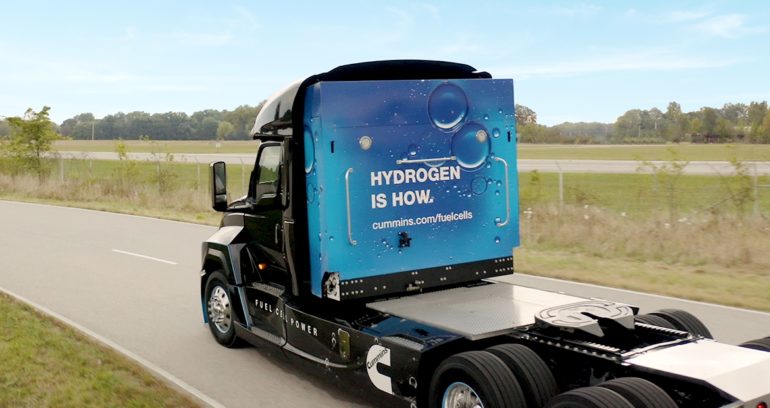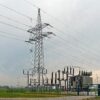Through a consortium of Department of Energy national laboratories, Oak Ridge National Laboratory scientists are applying their expertise to provide solutions that enable the commercialization of emission-free hydrogen fuel cell technology for heavy-duty vehicles, or HDV. As a viable alternative to internal combustion engines powered by gasoline, hydrogen fuel cells can provide sustainable, clean energy with a comparable user experience.
“Adoption of hydrogen technology in the HDV market could prove to be the breakthrough launching widespread use,” said ORNL’s David Cullen, a scientist in the Center for Nanophase Materials Sciences who studies fuel cell catalysts and electrode structures using advanced microscopy and spectroscopy. “Hydrogen fuel cells are ideal for the trucking industry because the refueling time and driving range are comparable to gasoline-powered trucks and travel routes are predictable, which lowers the barrier for developing a fueling infrastructure.”
Hydrogen fuel cells contain a higher amount of energy-per-unit mass than a lithium battery or diesel fuel. A truck can have a higher amount of energy available without significantly increasing the weight—an important consideration for long-haul trucks that have weight penalty policies.
In October 2020, the DOE Hydrogen and Fuel Cell Technologies Office, or HFTO, launched the Million Mile Fuel Cell Truck Consortium, or M2FCT, to support opportunities for fuel cell adoption in the HDV market through research and development and to align with DOE’s H2@Scale vision for clean and affordable hydrogen across multiple sectors in the economy. M2FCT, composed of five national laboratories, is working to meet the efficiency, durability and cost requirements of the trucking industry. With $50 million funded by HFTO over five years, the team has set a 2030 goal of demonstrating systems that have a 25,000-hour, or 1-million mile, lifetime for long-haul trucks.
“Transitioning to hydrogen fuel cell heavy-duty vehicles would have a significant impact on reducing greenhouse gas emissions,” said Lawrence Berkeley National Laboratory scientist Ahmet Kusoglu. Kusoglu notes that heavy-duty vehicles make up a small fraction of the vehicle fleet in the United States and travel only 10% of the total annual vehicle miles driven. But, according to the Environmental Protection Agency, they contribute 23% of transportation emissions of greenhouse gases and account for almost one-quarter of the fuel consumed annually in the U.S.
The M2FCT team outlined the current and future state of the technology and addressed the challenges to widescale adoption by the heavy-duty vehicle industry, including trucks, buses, trains and marine applications, in a recent Nature Energy review article. Cullen, coordination officer for M2FCT, is first author on the paper; co-authors include ORNL’s Karren More and M2FCT member scientists from Lawrence Berkeley National Laboratory, Los Alamos National Laboratory, National Renewable Energy Laboratory and Argonne National Laboratory.
“There are four pillars in this consortium: materials development, component integration, component and fuel cell durability and system analysis,” Cullen said. “But they mesh together and feed off each other. ORNL is working across all these areas through our characterization work.”
More, who directs ORNL’s Center for Nanophase Materials Sciences, a DOE Office of Science user facility, said ORNL will apply its unique capabilities and expertise in microstructural and microchemical analyses of fuel cell materials and components to better understand fuel cell performance and durability issues at the macroscopic down to the atomic level.
“We continue to develop novel characterization methods and data analytics to provide insight into the behavior of fuel cell materials used in heavy-duty applications,” she said. “ORNL provides innovative means to interrogate materials structure, chemistry and properties, such that performance and durability issues can be understood and solved in order to develop new materials with optimized properties.”
ORNL also is contributing roll-to-roll manufacturing expertise, which will be closely coordinated with NREL, to determine how to scale up the manufacturing processes for the membrane electrode assembly. Cullen said the team will be focused on developing new electrode structures that can be achieved using a roll-to-roll process rather than conventional spray-coating or ink deposition processes.
M2FCT represents a shift in direction after the conclusion of the Fuel Cell Performance and Durability, or FC-PAD, consortium, which focused on fuel cells for light-duty vehicles.
In late 2019, DOE’s HFTO, in collaboration with the Vehicle Technologies Office, released technical targets for hydrogen-fueled long-haul tractor trailer trucks, also known as Class 8 long-haul trucks. These targets set in motion the work M2FCT researchers are now embarking on by guiding early-stage R&D. The study recently released by M2FCT uses Class 8 long-haul trucks as a case study to show how different design characteristics impact efficiency and durability, as well as how the advancements made for light-duty vehicles can be leveraged to meet heavy-duty vehicle requirements.
Hydrogen fuel cells generate electricity through an electrochemical reaction between hydrogen and oxygen, which combine to generate electricity, heat and water. One fuel cell can generate about 300 watts of power; to generate enough power to run a car’s electric motor, the fuel cells need to be combined into a fuel cell stack.
To meet DOE’s targets for hydrogen-fueled long-haul tractor trailer trucks, M2FCT researchers have identified the key differences between designing hydrogen fuel cells for light-duty vehicles versus heavy-duty vehicles. Challenges, according to ANL chemist Deborah Myers, are that “heavy-duty vehicles require a higher cell voltage to achieve optimal efficiency in addition to a three- to five-times longer required lifetimes compared to light-duty vehicles, placing greater demands on the performance and durability of the fuel cell materials.” Solutions to this include materials research that explores how existing fuel-cell component materials operate and degrade under different temperature and humidity levels and at higher cell voltages, and development that examine how the integration of new materials can meet these challenges.
The M2FCT consortium brings together different areas of expertise related to fuel-cell efficiency and durability and communicates with industrial developers. While the team’s initial focus is on hydrogen-fueled long-haul tractor trailer trucks, M2FCT researchers are also optimistic about the potential adoption of hydrogen fuel cells in other, more demanding heavy-duty applications including trains, maritime and even aviation.
“Hydrogen is a versatile energy carrier, which is encapsulated in the H2@Scale concept. You can store energy in hydrogen bonds and this is of particular interest for long-term or seasonal energy storage. You can use it in a truck or industrial sectors, but you can also convert it back to electricity to put into the grid,” Cullen said. “We’re seeing a snowballing interest in hydrogen as an energy carrier, and not just for vehicles.”
Commercial truck electrification is within reach
More information:
David A. Cullen et al. New roads and challenges for fuel cells in heavy-duty transportation, Nature Energy (2021). DOI: 10.1038/s41560-021-00775-z
Provided by
Oak Ridge National Laboratory
Citation:
Heavy-duty vehicles an ideal entry into hydrogen fuel cell use (2021, April 23)
retrieved 23 April 2021
from https://techxplore.com/news/2021-04-heavy-duty-vehicles-ideal-entry-hydrogen.html
This document is subject to copyright. Apart from any fair dealing for the purpose of private study or research, no
part may be reproduced without the written permission. The content is provided for information purposes only.



